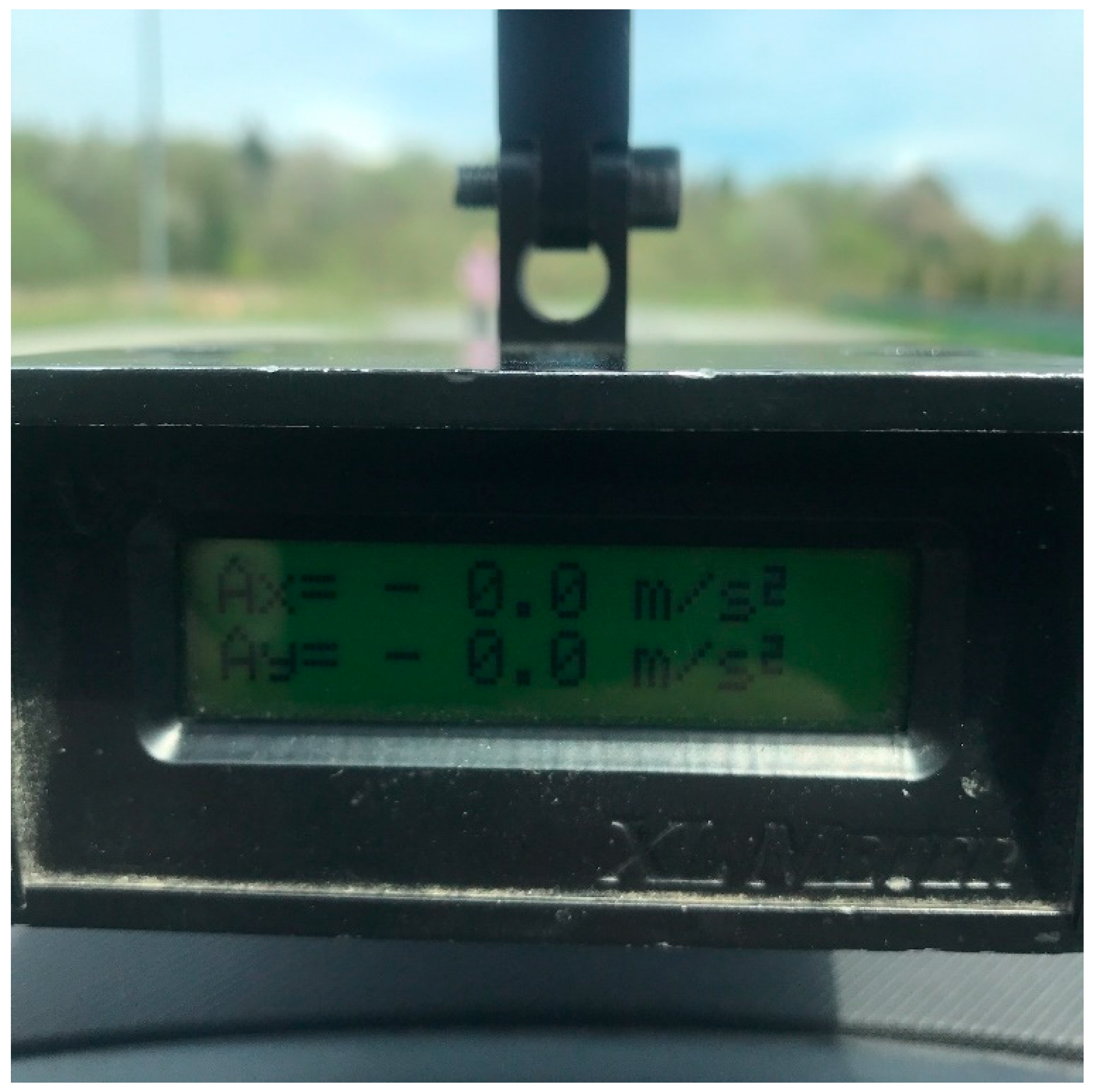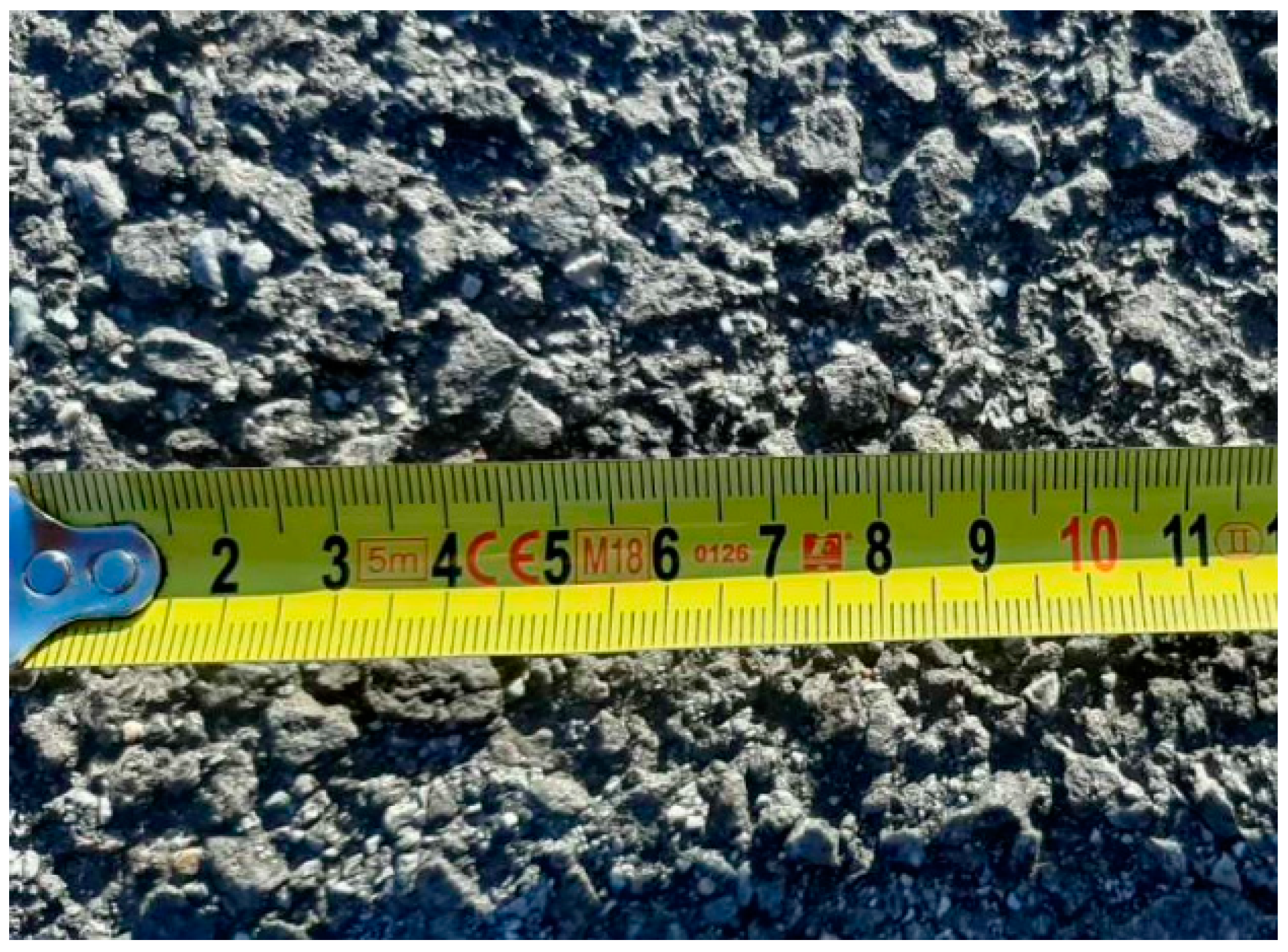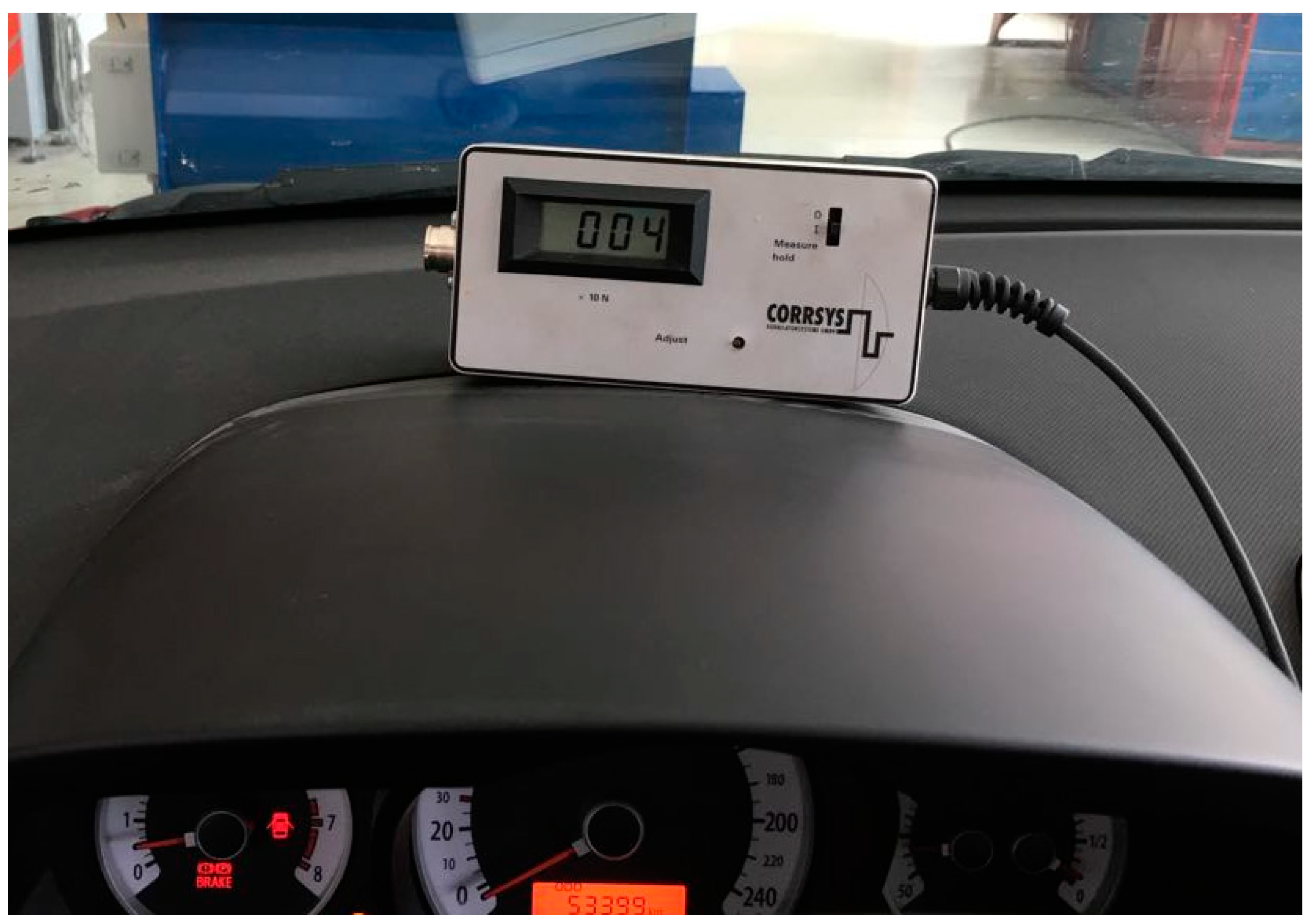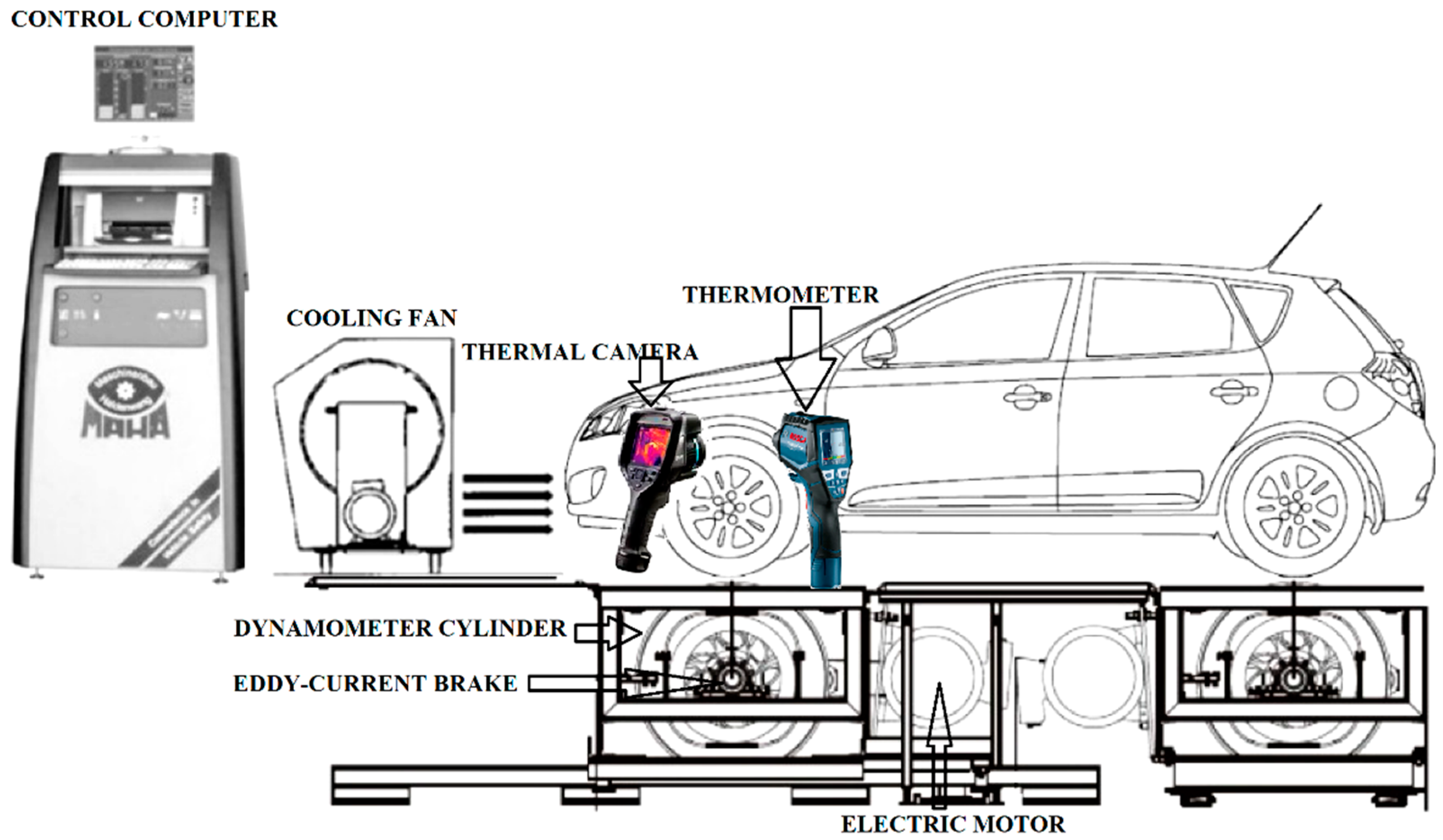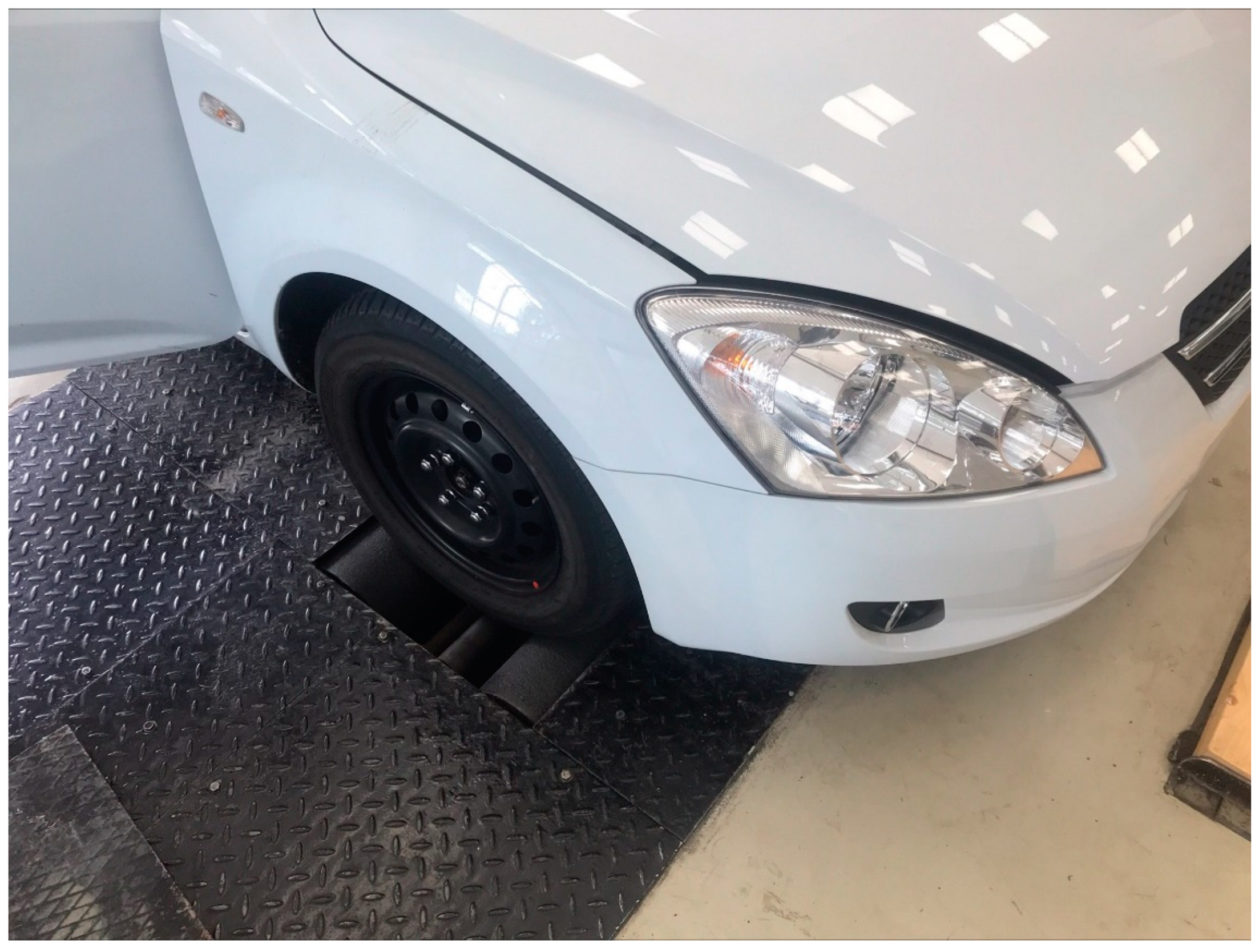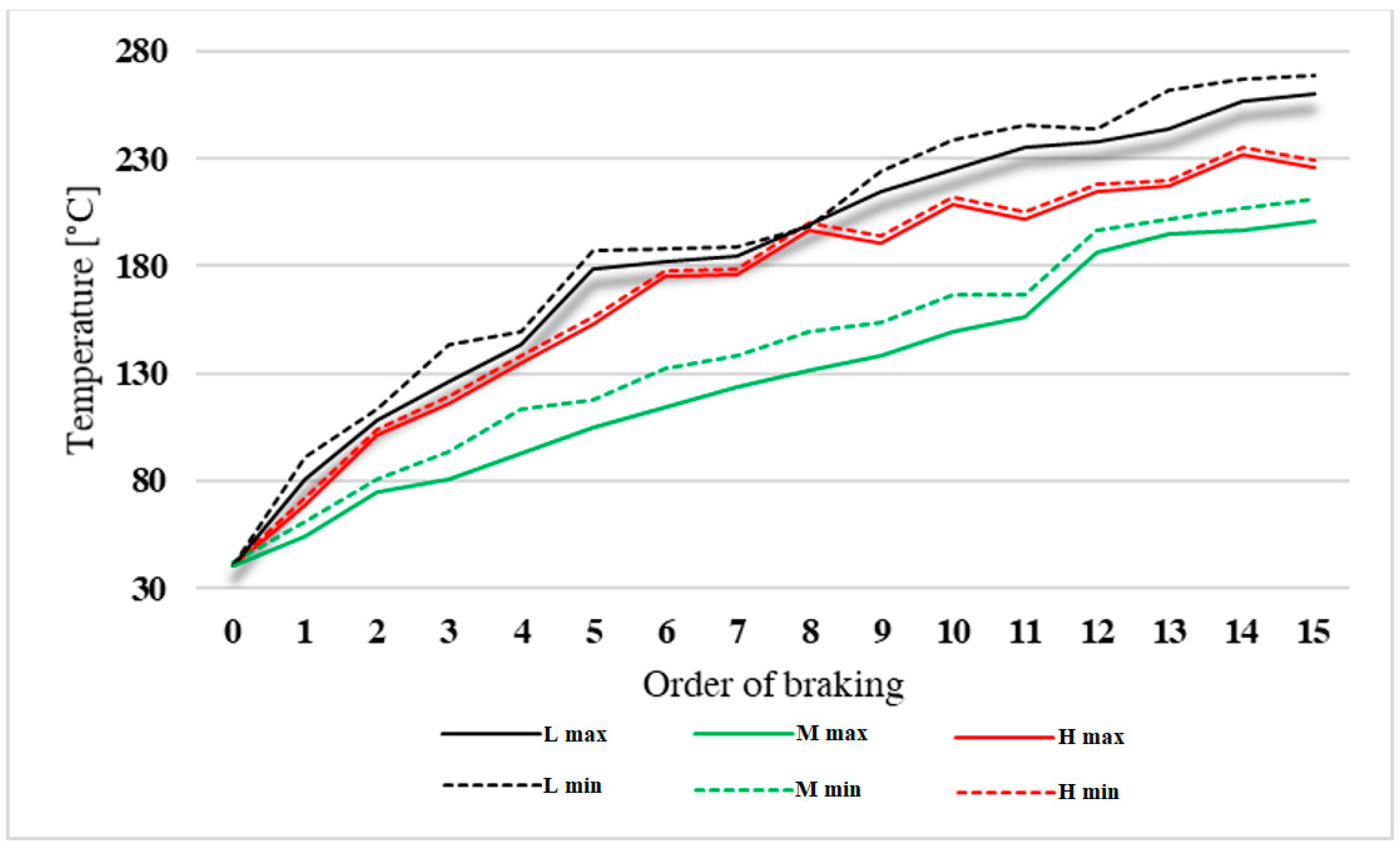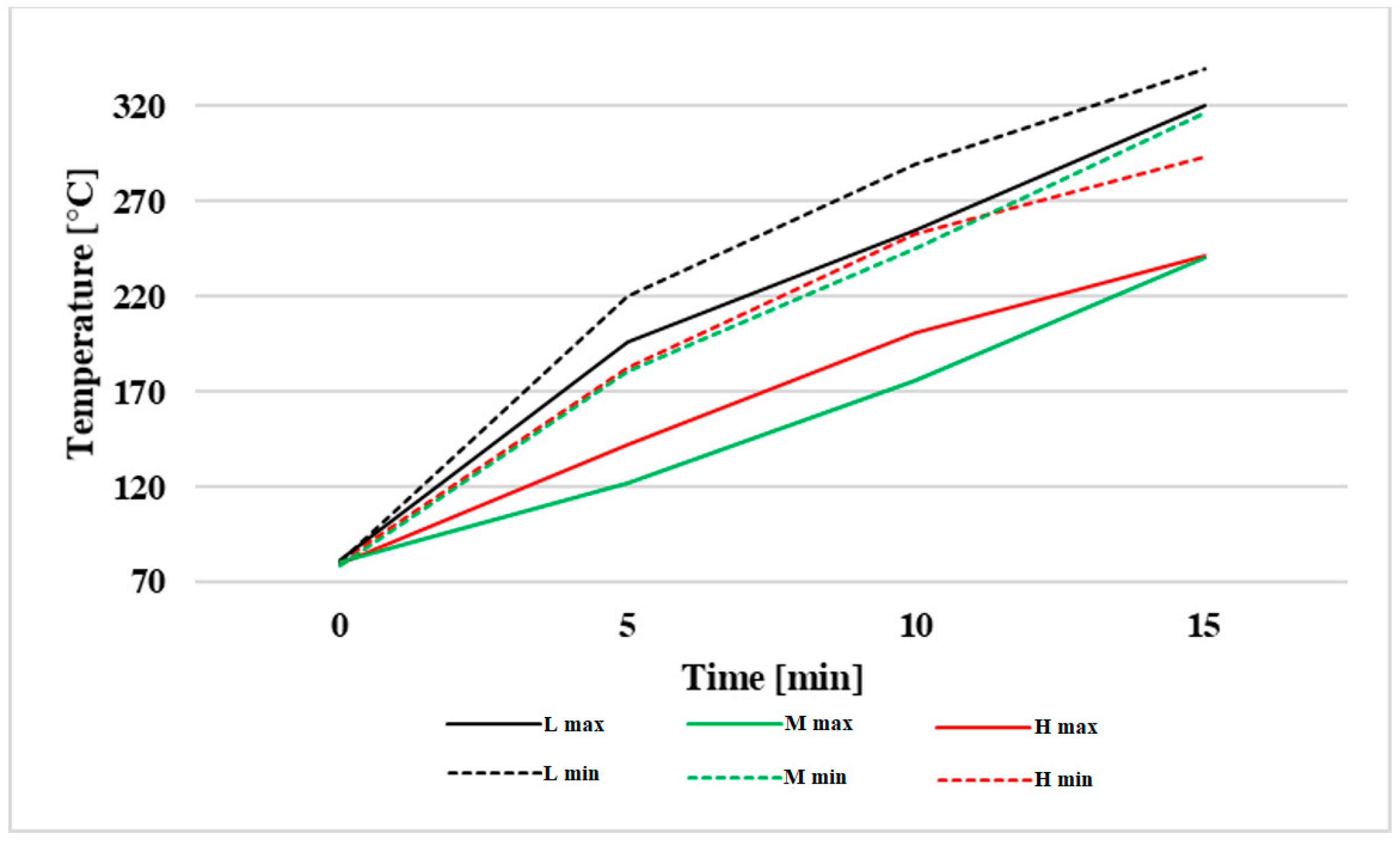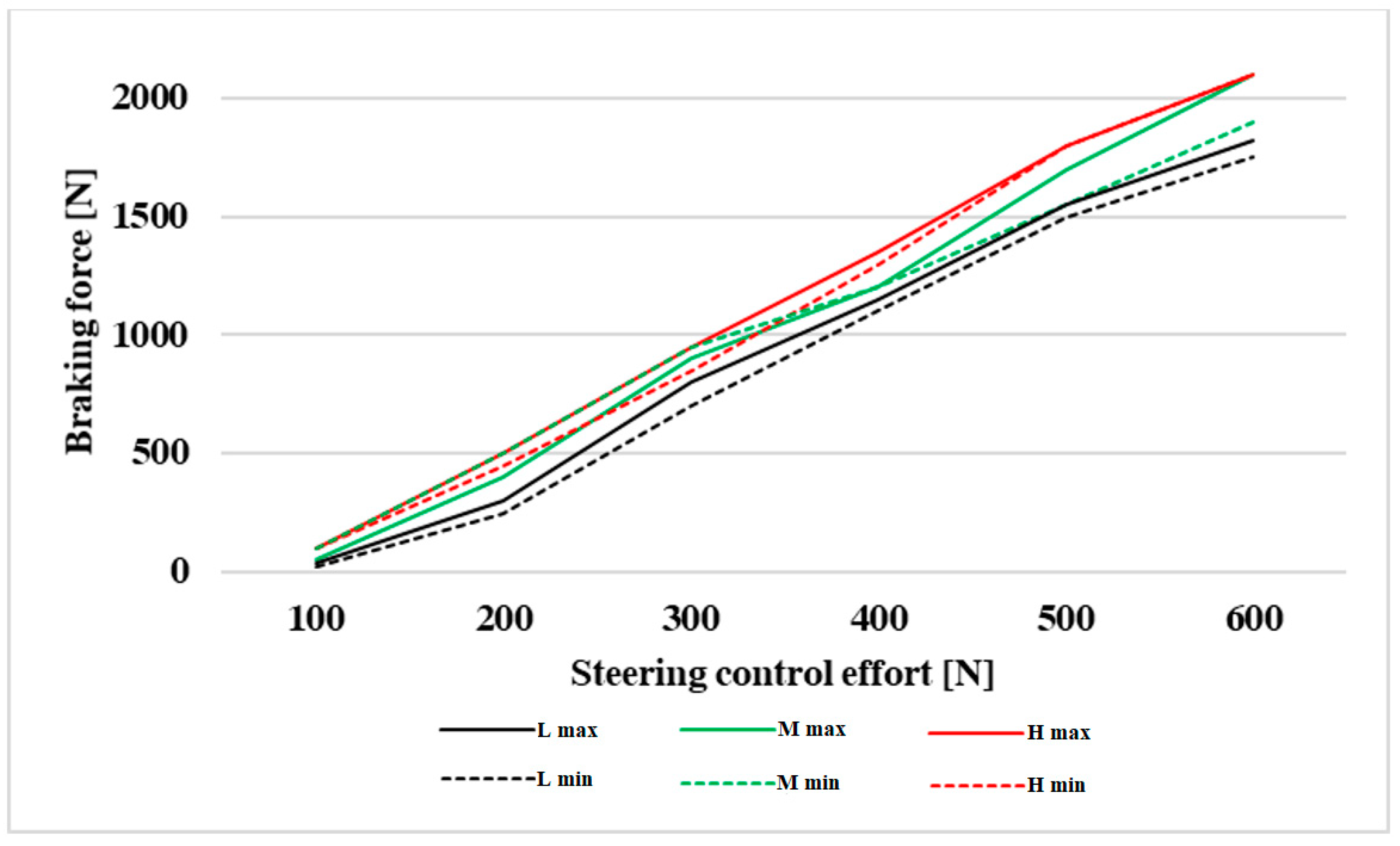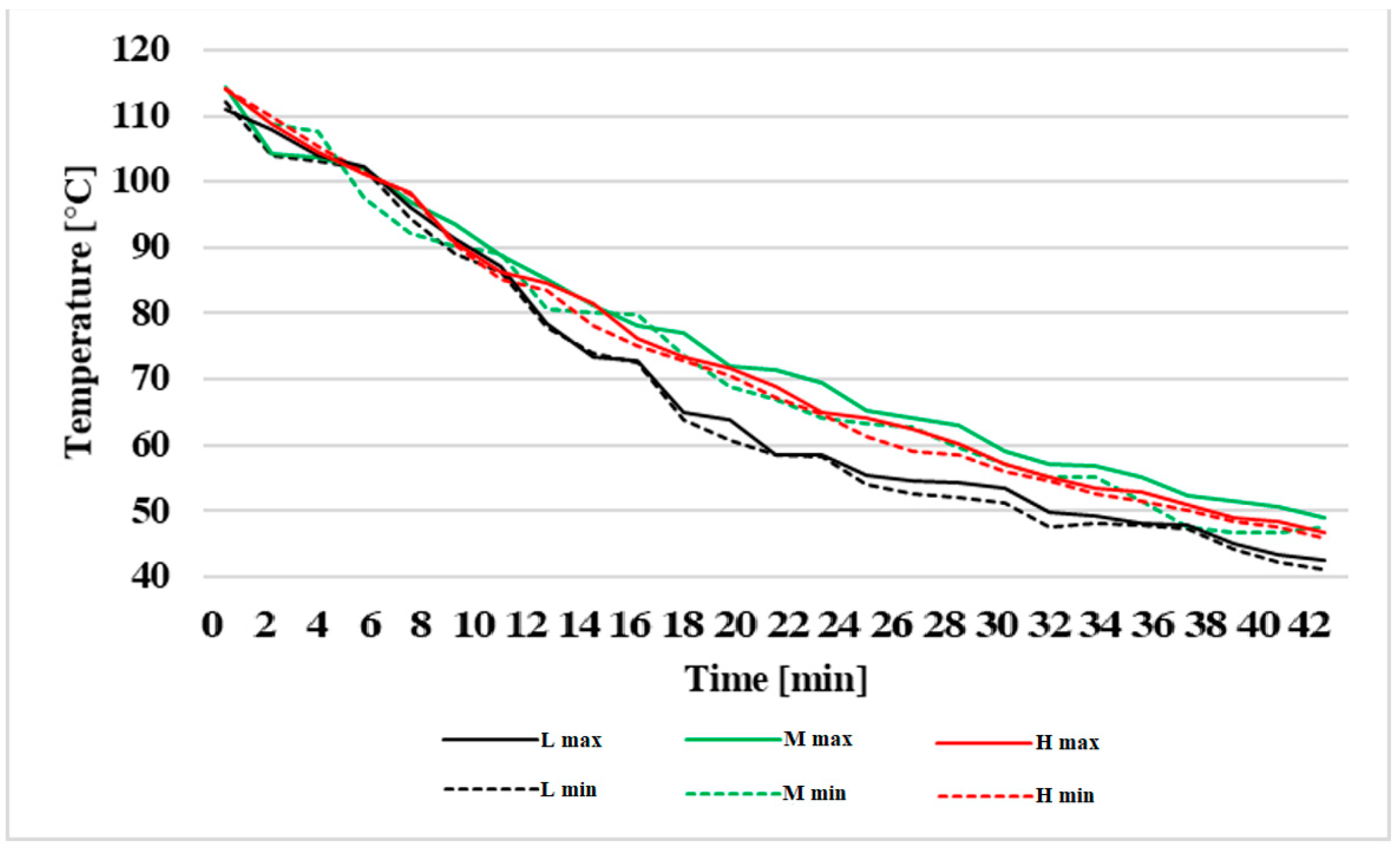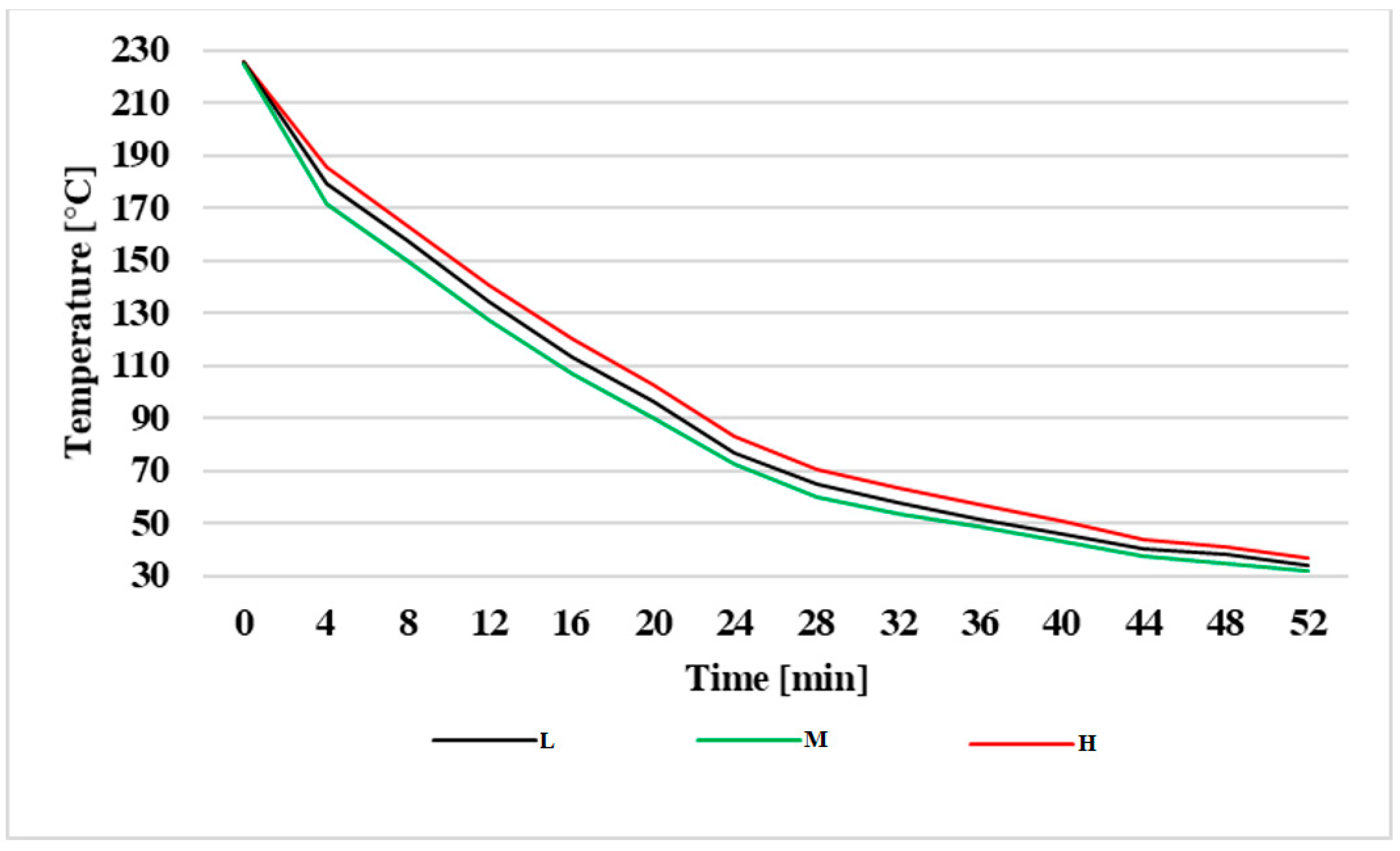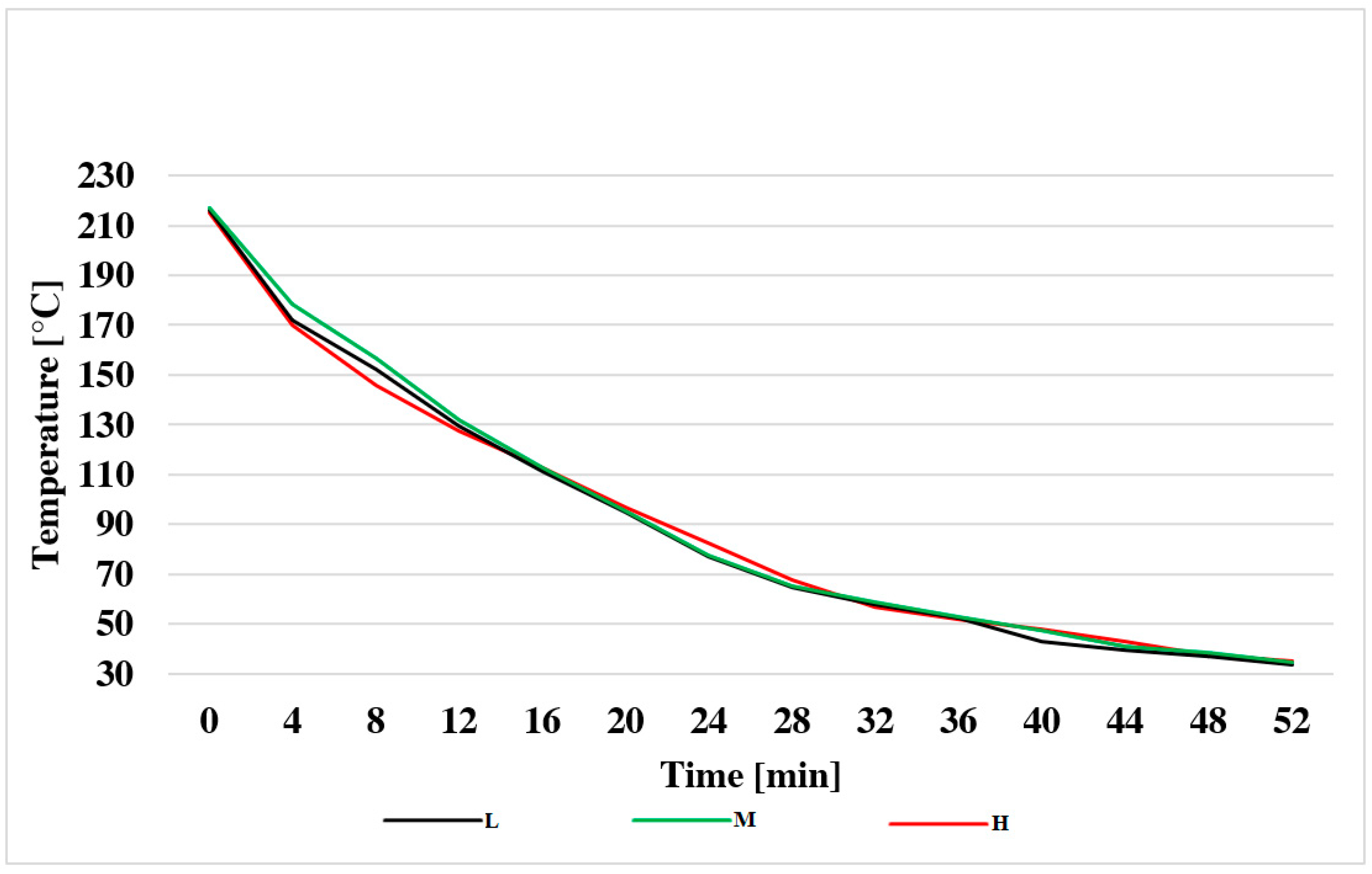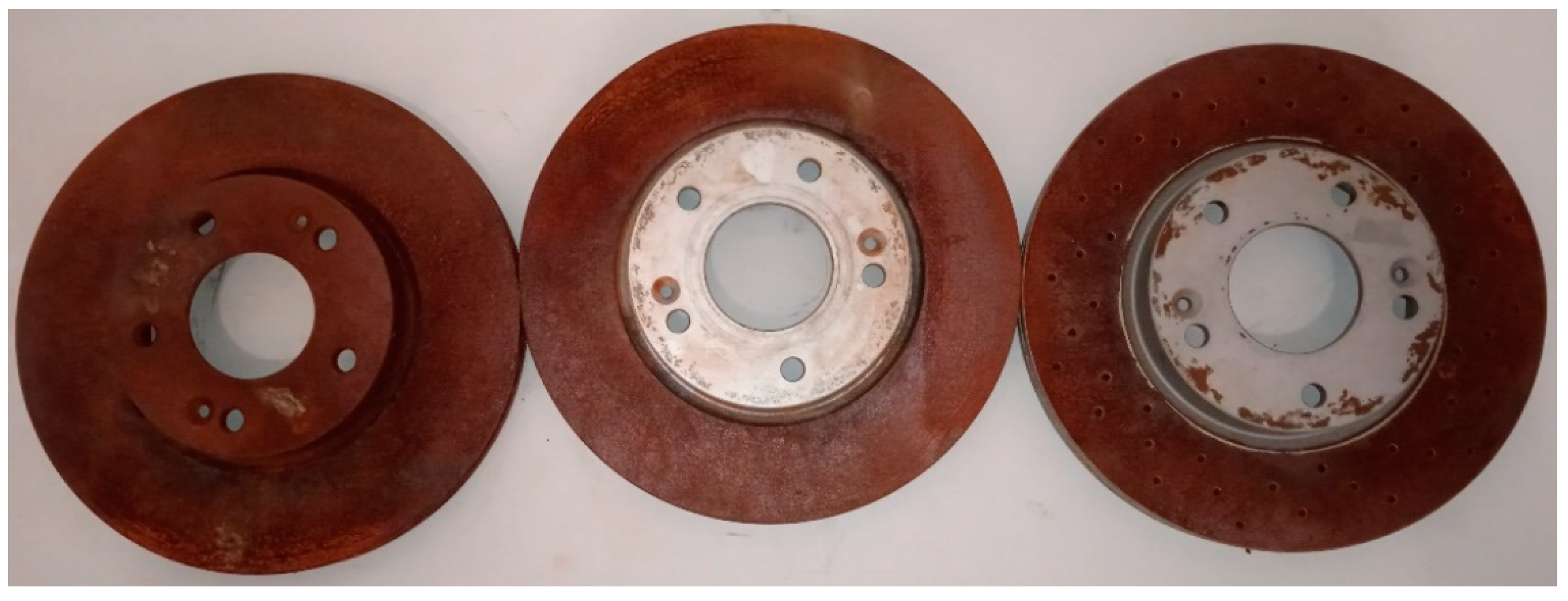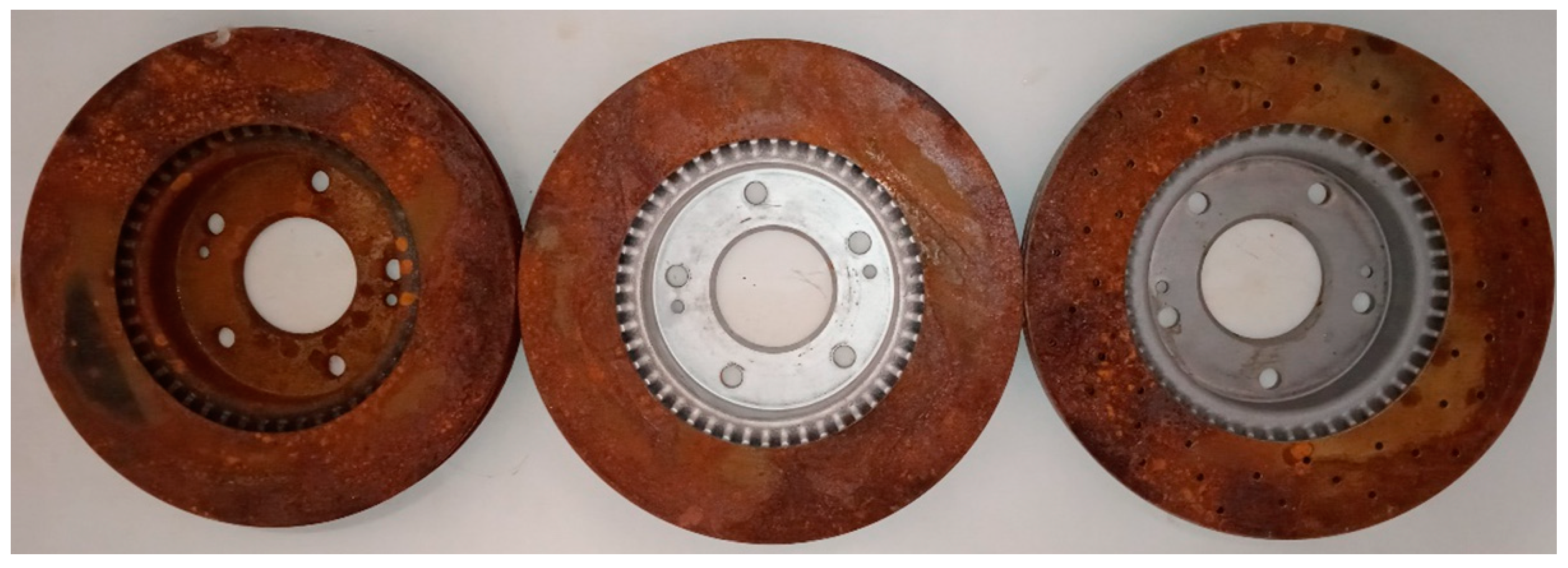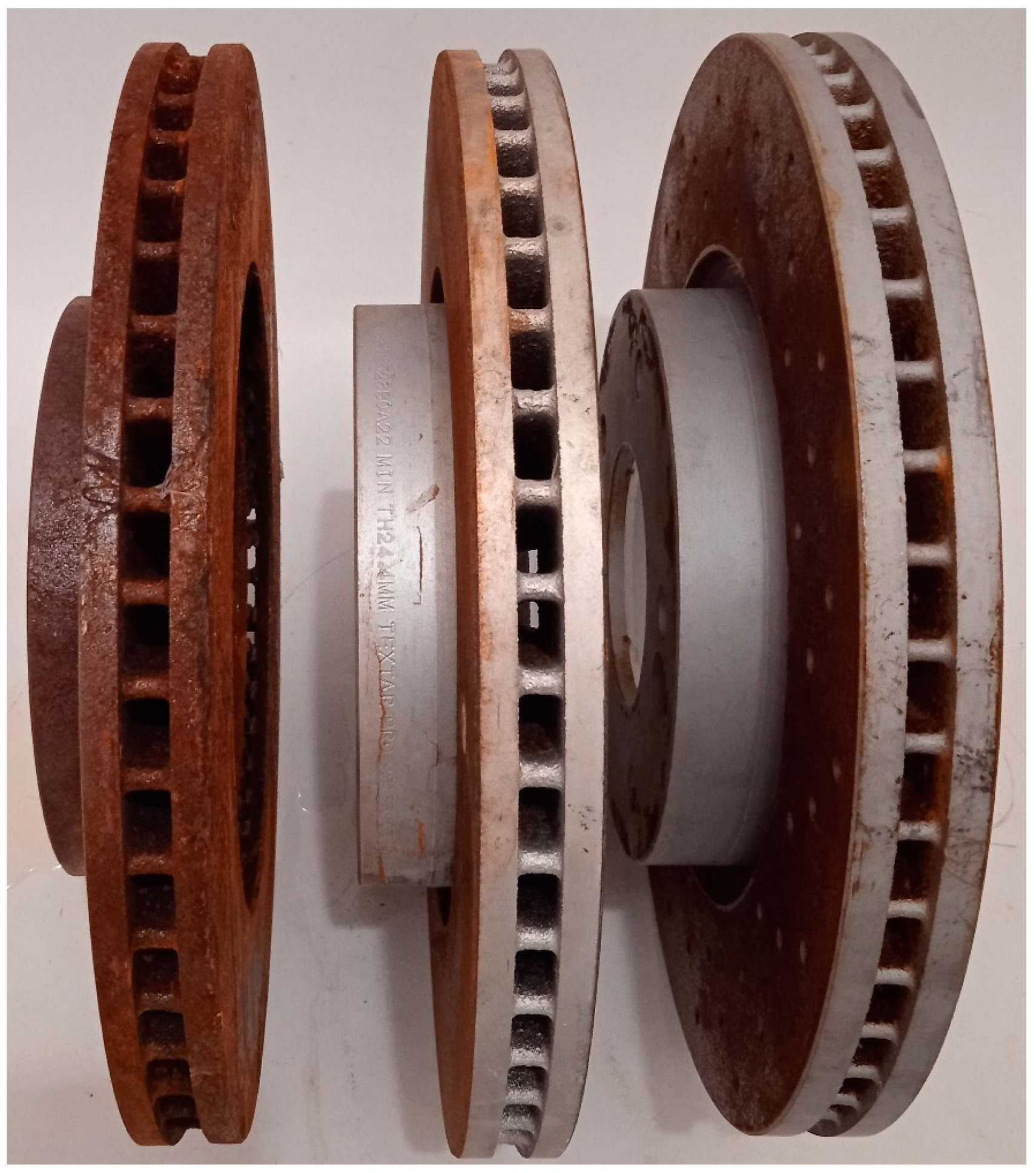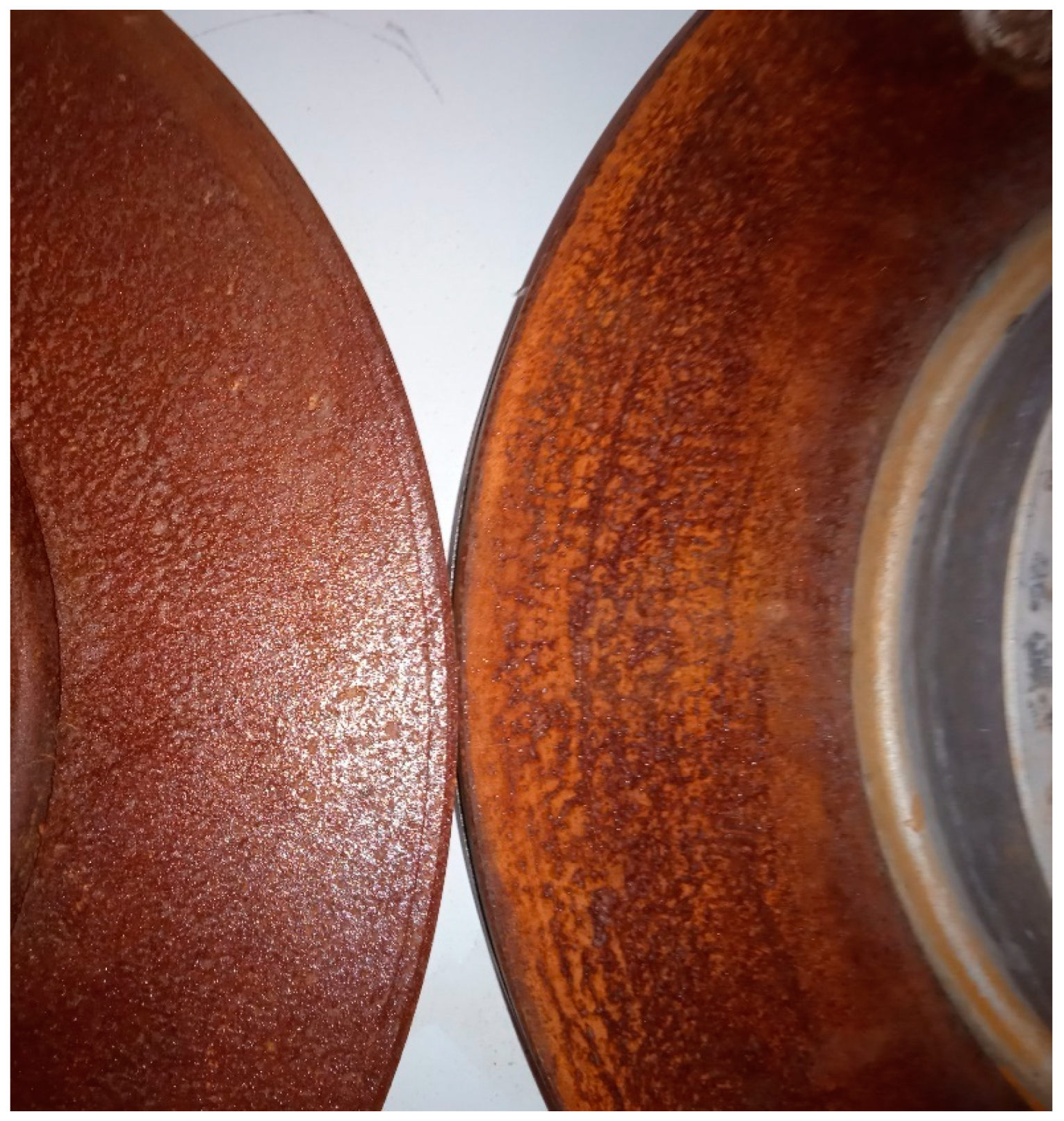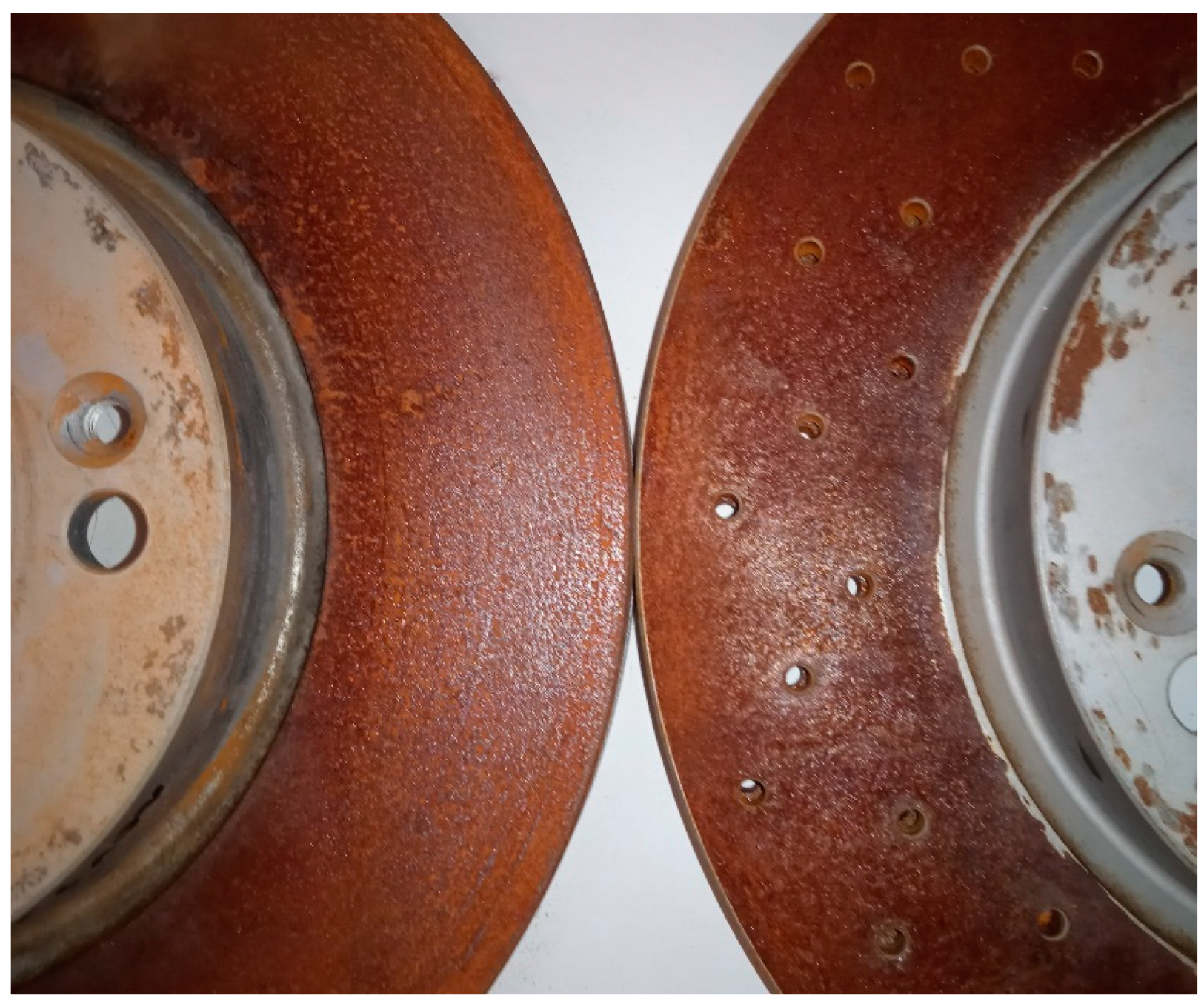1. Introduction
Friction brakes convert a vehicle’s kinetic energy to predominantly thermal energy [
1,
2]. The frictional force is caused by the brake pads’ force applied on the brake discs. There are many demands placed on them all, sometimes contradictory.
Brake discs are un-sprung parts of a vehicle, and are rotating masses which act against inertia in the rotary direction when the vehicle is accelerating and decelerating [
3]. Thus, the weight of disc brakes affects the driving and operational vehicle performance, and it should be as low as possible. In order to lower their weight, traditional materials used for their production are replaced by lightweight ones. In addition to grey cast iron and steel, lighter materials are used for the production of disc brakes, which do not excessively increase the price of the product and also meet strength, frictional and thermal requirements [
4]. Criteria for materials to be used for a brake disc are also mentioned in the publication [
5]. To have a lower weight brake disc as well as to keep its strength at the required level, a combination of aluminium and alloy can be used. The publication [
6] describes how the weight of a brake disc is lowered by 20% by using aluminium in the assembling section, and how grey iron is applied in the friction surface section to maintain braking performance. Materials are combined either by casting or by a bolted joint [
7]. The reliability and contributions of lightweight brake discs have been verified by the brake dynamometer [
6].
Brake pads must withstand high temperatures and pressures while maintaining an adequate coefficient of friction as well [
8]. Their lifetime must be as long as possible while at the same time retaining their original performance and having minimal wear [
9]. The production of friction lining most often uses mineral, metal or ceramic organic materials in powder or fibre forms. These materials are bound by vitreous, metal or carbon fibres [
10,
11]. There are also biomaterials used, mainly from agricultural production, as mentioned in the publications [
12,
13,
14].
Brake discs and pads must create such a pair which is able to generate intense brake forces in a short moment. The intensity of brake force is affected by the force of the brake cylinder that is applied on the brake pads, and by the coefficient of friction between the brake pads and a brake disc [
15,
16]. If the brake pads are made of material that is too lightweight, this will first lead to their deformation and, after that, to the activation of required braking force [
17]. That would mean that the time for brake activation as well as stopping distance will be prolonged [
18].
The heat accumulated in the brake disc and brake pads can to some extent increase the coefficient of friction. Higher temperatures can cause an increase in the coefficient of friction. After exceeding a certain temperature, usually 350 °C continuously and 800 °C at peak time, it can lead to permanent adverse modifications [
19,
20].
The overheating of brake discs and brake pads can occur due to various reasons [
21]. High temperatures can be caused by intense and long-lasting braking when a vehicle is driving downhill [
22]. This problem is predominantly connected to heavy vehicles, as also described in the publications [
23,
24,
25]. However, mostly due to bad braking strategy, the risk of brakes overheating may occur in passenger vehicles as well [
26,
27,
28].
Overheating can also happen even when braking normally, if the brake disc or brake pads are made of improper material with the wrong value of thermal conductivity [
29,
30]. Overheating may occur due to the wrong material combination of a brake disc with brake pads as well, which is also seen in the publications [
31,
32].
The publications [
33,
34] pay attention to overheating of brake discs and pads as a result of their insufficient thickness. Publication [
34] mentions that the reduction inof a brake disc’s thickness from 23 mm to 17 mm causes an increase in temperature during deceleration by 8.27% and in thermal stress by 12.82%. It is necessary to inspect brake discs and brake pads regularly, and if they are not thick enough, they must be replaced immediately since it can lead to their overheating.
If the brake pads do not turn back to their original position after braking, it leads to continuous contact between the brake pads and brake disc, resulting in constant braking as well as converting kinetic energy into thermal [
35]. The reason for not turning back after braking may be a malfunction in the braking system, for instance due to seizure of pins in the brake master cylinder or seizure of the cylinder in the brake. If the combination of materials is inappropriate, or if the surface treatment is insufficient, it can lead to a reaction between the brake pads and any spot they contact where they are located in the brake calliper. Then, corrosion and seizure can occur [
36]. Due to excessive temperatures, the components can be seized even more, and thus the friction and temperatures are higher.
Heat can lead to the formation of a smooth boundary film on the brake discs and pads. The layer of film causes a decrease in the coefficient of friction as well as in the braking force. To generate the same braking force, generating a higher effort is needed to control the steering [
37]. The boundary film causes another increase in temperature, and higher temperatures increase the creation of boundary film. This can be also evinced by whistling [
38]. In an extreme case, it can lead to the situation when even the maximum possible effort to control the steering generated may not be enough to generate sufficient braking force [
39]. A brake disc with a boundary film must be replaced by a new one. Some drivers do not replace them, or put off replacement due to cost. This leads to reduction in their thickness and to risk of damaging them [
33,
34,
40].
Due to high temperatures and heat shock, various cracks can occur on the brake disc’s friction surface [
41]. The publication [
42] has concluded that thermal stress on the brake disc while braking is substantially higher than mechanical stress. Gradually, these cracks expand, and thus, while braking, the brake disc may crack [
43]. The risk of cracking may also be higher if the brake disc is equipped with cooling holes, as mentioned in the publication [
1].
Heat is transported from the brake disc by flowing into the wheel’s hub, in which the bearing is located. In extreme cases, due to excessive heat load, it may lead to loss of greasing abilities of the grease, damage in the bearing and its seizure or to wheel blocking [
44]. Overheating as the main reason for the bearing being seized has been also mentioned by the researchers in the publication [
45].
The heat is also transported from the brake disc and brake pad to the brake cylinder, which is in direct contact with the brake fluid. Brake fluid is hygroscopic and intakes water through rubber hoses and seals [
46]. An important parameter of brake fluid is its wet boiling point, which is about 180 °C [
47]. After breaking this limit, the water in brake fluid starts to boil. Water is converted by boiling into steam, and steam water is, in comparison with fluid, compressible [
48]. The boiling point decreases with the age of brake fluid, since the amount of intake water increases [
49]. According to data in the publication [
50], 11% of the 159 vehicles tested had brake fluid boiling points lower than 155 °C. Compressibility of steam may cause partial or complete dysfunction of the brake control [
51].
If the temperature of brakes is too high, it is evinced by unpleasant odour, emission of dangerous volatile substances, overheating of the wheel guards, damaging of rubber seals as well as several other activities as also mentioned in the publications [
52,
53,
54]. Publication [
52] specifies that exceeding the temperature of brake discs from about 165 °C to 190 °C leads to a four- to six-fold increase in emission production of ultrafine particles.
An important characteristic of brake discs is their resistance level against corrosion, which is also observed in the publications [
55,
56,
57]. Corrosion on the friction surfaces of brake discs can cause an excessive increase in the temperature of brake discs and brake pads, as well as a reduction in the coefficient of friction, resulting in the reduction in braking force and lengthening of stopping distance [
58]. The publication [
59] focused on the impact of corrosion on a vehicle’s braking characteristics, although the constituent material of brake discs was the same.
Corrosion on the brake discs’ friction surface increasingly causes the brake pads to be being worn out and it can lead to their total destruction [
60]. There is also a risk of strong adhesion due to friction, as also mentioned in the publications in which the attention was predominantly paid to the discs made of grey cast iron [
61,
62,
63]. Fluctuation and inequality in braking may be caused by corrosion on the brake discs’ friction surface as well. The relation between corrosion and vibration intensity was described in the publication [
64], in which it was determined by a numerical simulation, and also in the publication [
65], in which it was also determined by experimental testing.
Brake disc corrosion can cause permanent friction [
66,
67]. This leads to an increase in a vehicle’s mechanical resistances followed by increased fuel consumption, amount of non-renewable resources consumed, as well as the amount of gaseous and dust emissions. Part of the engine power and torque is being spent to overcome friction, and it is converted to thermal energy. Thus, a vehicle achieves lower acceleration, and it may increase the possibility of a car accident, for example when moving from a side road to a main road or when overtaking other vehicles [
68].
In combination with electric braking systems such as ABS, corrosion can make the brake discs malfunction [
69].
Corrosion on the contact areas of a brake disc causes its improper fixation to a wheel nave, resulting in the fluctuation of braking effect, brake pedal and steering wheel vibrations, overheating, as well as irretrievable damage to the brake disc, which must then be replaced [
70].
Formation of corrosion in areas where a brake disc is in contact with a wheel nave or wheel disc can damage the wheel and cause disassembly of the brake disc. This requires using higher force and thrust, and thus, it increases the risk of damaging the wheel, wheel nave’s bearing and the brake disc itself. Disassembly results in time-consuming, high-cost fixes [
71,
72].
Reinforcing the corrosion resistance can also be achieved by alloying elements. The publication [
55] described the corrosion resistance increased by a higher amount of aluminium and by correct fine-tuning of alloying elements. The manuscript [
55] aimed at demonstrating that the fine-tuning of alloying elements in cast iron is a particularly effective method in order to improve its corrosion resistance, thus allowing the development of future disc brake rotors with a prolonged operating life. The authors in the publication [
57] concluded that it is possible to mitigate the corrosion of cast iron brake discs by modulating the carbon morphology, alloy element concentration and microstructure. Increasing the corrosion resistance is also possible via ferritic nitrocarburizing (FNC), as also mentioned in the publication [
73], in which the authors studied the effect of the brake friction value by FNC compound layer thickness with scaled dynamometer testing, and determined the anti-corrosion performance results for each respective case via complex environment salt spray testing. Corrosion resistance is provided by using ceramics as well. This subject matter is described in the publications [
74,
75]. When increasing the corrosion resistance of brake discs, it is always connected with increasing the financial effort, which may be reflected in the final price of brake discs. This can lead to the decision to not apply the additional corrosion resistance.
The technical parameters of a vehicle can also be affected by its age. Sales of new vehicles in the European Union in 2021 have decreased by 25% in comparison with the previous year, and the average age of vehicles is 11.5 years [
76,
77]. Lower sales of new vehicles and higher age of used ones premise worse technical conditions of vehicles and the need for purchasing spare parts [
78,
79]. According to the publications [
80,
81,
82], choice of spare parts for passenger vehicles has been affected by their price, population purchasing power, age of a vehicle and awareness of differences between particular spare parts. It is possible to buy brake discs and brake pads of different prices for one vehicle [
83]. The differences in their price due to many factors. The brake discs and brake pads in all price ranges must meet the same requirements to be used in a certain vehicle with the same safety and ecology levels [
84]. All brake components which can be purchased for a specific vehicle have had to be tested several times and meet the required parameters. Since the brake components at very different prices can be purchased for the same vehicle, there is a question whether the price of brake components affects their quality. It is one thing to meet the legislative parameters, and quite another to meet the requirements in excess of minimum legislative requirements. The purpose of this article is to assess different brake discs and brake pads intended for passenger cars from different points of view. The purchased and assessed brake discs and brake pads are of the lowest, middle and highest price in the market. The brake discs purchased are full as well as drilled. They were assessed in terms of their weight and volume. Sets of brake discs together with brake pads were assessed in terms of their impact on stopping distance, mean fully developed deceleration and ability to generate braking force. They were also assessed within their temperature range during repeated braking, continuous braking and cooling in open space. The brake discs’ corrosion resistance was also observed. The measurements were performed in the laboratory and via test driving. The contribution of this article lies in its complexity and number of measurements performed. The comparison of low-priced and high-priced brake discs and brake pads from the point of view of stopping distance and MFDD value is also mentioned in the publication [
85], but the measurements determined substantially lower parameters. Only the impact of brake discs and brake pads on the stopping distance and mean fully developed deceleration was assessed there, not their impact on the heating up or the ability to generate braking force. The advantage of this publication, compared to the publication [
85], lies in a considerably higher measurement complexity. In the publication [
86], brake discs selling at four different prices were assessed. Determining their impact on stopping distance and MFDD was performed with the same brake discs. The publication [
64], as well as the publication [
86], include only the measurements of stopping distances, not the brakes’ heating or the ability to generate braking force. When assessing the brake heating, there are usually only mathematical simulations used, as also seen in the publications [
87,
88,
89], and real measurements are rare. As mentioned in the publication [
87], mathematical modelling is often performed with various simplifications, such as considering the coefficient of friction as a constant value that is not dependent on the temperature, or considering the constant pressure between a brake pad and a brake disc. However, in fact, these conditions may not take place at all, and, thus, it can affect the results. During mathematical modelling, it is not possible to consider all the possible factors that can affect the braking characteristics or the brakes’ temperature. The advantage of the results achieved by experimental measurements lies in capturing all the factors which to lesser or greater degree affect the consequences. The results in this publication were achieved after considering more or less foreseeable facts such as a certain degree of material homogeneity, deviations in geometry and sizes of brake discs and pads, as well as in their materials and shapes, and many others. The complex experimental measurements enabled this consideration of all the factors.
The purpose of this publication is to assess the brake components from a predominantly operational point of view. Material and geometrical properties of brake components are not detailed. The article mainly focuses on the performance of brake components. The main objective is not to observe the material, but to assess the operational side of brake components.
2. Materials and Methods
The purpose of the measurements is compare the brake pads and brake discs, i.e., brake components of a passenger vehicle, from the perspective of heating up and ability to generate braking force.
Table 1 shows the technical parameters of a passenger vehicle of which the components are compared. Prior to measurement, new brake cylinders were mounted and all the brake fluid was replaced to avoid affecting the results.
The measurements were performed with three different brake discs selected according to their price. The brake discs’ purchase price is as follows:
Low-priced, EUR 20 per item,
Figure 1 on the left.
Mid-priced, EUR 50 per item,
Figure 1 in the middle.
High-priced, EUR 70 per item,
Figure 1 on the right.
The brake discs in
Figure 1 are displayed as they are seen by a vehicle operator, mechanic or purchaser. The manufacturer of the brake discs or brake pads does not provide their material composition.
The low-priced and mid-priced brake discs (
Figure 1 on the left and in the middle) have a full profile, while the high-priced brake disc (
Figure 1 on the right) has holes drilled for better cooling.
The brake pads intended for measuring are as follows:
Low-priced, EUR 11 per set.
Mid-priced, EUR 34 per set.
High-priced, EUR 49 per set.
The low-priced brake discs were used with low-priced brake pads, the mid-priced brake discs were used with mid-priced brake pads, and the high-priced brake discs were used with high-priced brake pads.
The measurements performed are given in
Table 2.
2.1. Measuring the Basic Physical Characteristics of Brake Discs
The first part of the measurements comprised determining the weight of the brake discs and the volume of the brake discs’ material. Subsequently, their density, i.e., their volumetric mass density, was calculated. The volume of the brake discs’ material was determined by immersion of the disc in the measuring cylinder with water and then by measuring the volume of water pushed by the brake disc.
The wobble of the brake discs was measured as well. During measurements, the brake discs were attached to the headstock spindle in order to ensure the highest measurement accuracy possible. Subsequently, the wobble was measured while slowly turning the discs via a mechanical dial gauge with a measurement accuracy of 0.005 mm.
2.2. The First Measurement of Vehicle’s Braking Characteristics
Vehicle’s braking characteristics measured included:
The MFDD decelerometer calculates according to Equation (1):
where MFDD is mean fully developed deceleration (m.s
−2);
vb is vehicle speed at 0.8 from v0 (km.h−1);
v0 is initial vehicle speed (km.h−1);
ve is vehicle speed at 0.1 from v0 (km.h−1);
se is distance driven between v0 and vb (m);
sn is distance driven between v0 and ve (m).
Measurements of braking characteristics were performed by a Inventure XL meter
TM Pro Gamma decelerometer (
Figure 2).
The decelerometer was located in the middle of the windscreen. Technical parameters of the decelerometer used are given in
Table 3.
The measurements were performed on a dry asphalt surface of which the grain size is given in
Figure 3.
Prior to measurements, a 5 km long route with particular brake components was driven each time, during which braking was performed continuously. There were 8 measurements performed with the low-priced, mid-priced and high-priced brake components at an initial driving speed of approximately 50 km.h
−1. Then, the results were averaged. The driver accelerated the vehicle to the speed of 50 km.h
−1, and when the front part of the vehicle reached the beginning of the braking section signposted by a traffic cone, the accelerator pedal was released as fast as possible and the brake pedal was applied. The same effort to control the steering affecting the brake pedal was controlled by a Corsys pedometer during all the measurements (
Figure 4).
2.3. Measurement of Brake Discs’ Temperature during Repeated Braking 15 Times in a Row
After determining the impact of the brake components used on the braking characteristics of a vehicle, the measurement of the temperature of brake discs during repeated braking was performed. To avoid a distortion of the results by the environment, the measurements were performed under laboratory conditions on the MAHA MSR 1050 dynamometer. The air temperature in the laboratory varied from 18 °C to 22 °C. Prior to each measurement with changed brake components, the vehicle was left for at least 6 h without any motion to reduce the wheel’s hub, brake calliper, brake cylinder and the other components to an ambient temperature to avoid a distortion of the results.
The layout during the measurement is given in
Figure 5.
The MAHA MSR 1050 dynamometer is able to simulate a vehicle driving on a road while keeping the real values of all driving resistances. Real driving is simulated as the control computer instructs the electric motors which further spin the dynamometer’s cylinders, or it instructs the eddy-current brakes by which the cylinders are braked. In order to simulate the same driving conditions with the dynamometer MAHA MSR 1050 as for road driving, especially the inertia resistance while braking, it was necessary to insert the values of driving resistances from the Kia Ceed into the control computer. The driving resistances were determined by the coasting deceleration measurement of vehicle resistance under conditions pursuant to EN 30 0556 [
92]. The vehicle accelerates to the speed of 120 km.h
−1 and then the wheels are disconnected from the engine by putting the transmission in neutral. The vehicle further freely decelerates, and its speed is recorded according to the time spent from the moment of the wheels’ disconnection. The Kia Ceed’s coasting curve is shown in
Figure 6.
The data measured with the vehicle mass were inserted into the MAHA MSR 1050 dynamometer’s computer and the repeated coasting deceleration measurements of vehicle resistances were performed to determine the change in rolling resistance due to the dynamometer’s round cylinders.
The conditions of repeated braking were adapted to the conditions given in general binding ECE Regulation No 13H type I [
93], however, with a change: it is necessary for the wheels to be fully stopped at each braking in order to measure the brake disc’s temperature. To meet the requirements of ECE Regulation No 13H as well as to stop the wheels, the following condition must be respected (Equation (2)):
where ΔEKEHK is the difference in kinetic energies at the beginning and at the end of one braking cycle according to ECE No 13 H, and ΔEKDYN is the difference in kinetic energies at the beginning and at the end of one surrogate braking cycle for MAHA MSR.
The value of kinetic energy converted into the thermal energy while vehicle braking according to ECE NO 13 H must be the same as the value of kinetic energy converted into the thermal energy while braking on the dynamometer, as in Equation (3). While measuring with dynamometer, the following must be applied:
where
m is vehicle mass (kg);
v1 is initial speed at the beginning of braking according to ECE No 13 H (m.s−1);
v2 is speed at the end of braking according to ECE No 13 H (m.s−1);
vA is initial speed wanted at the beginning of surrogate braking cycle (m.s−1);
vB is speed at the end of the surrogate braking cycle, VB = 0 (m.s−1).
For heat diffusing, the time during which the heat is diffused is also important. To maintain the time when kinetic energy is converted into thermal energy, it is necessary to calculate the time of braking using Equation (4):
where
b is deceleration required according to ECE No 13 H, 3 m.s
−2;
Δv is speed difference at the beginning and at the end of deceleration (m.s−1);
t is time needed for achieving the change required during deceleration (s).
Derived from Equations (2) and (3), the initial speed of braking was calculated as v1 = 103.9 km.h−1, and, from this speed to the zero speed, the time of braking was derived from Equation (4) t = 5.56 s.
The vehicle in which the brake discs were heated to 40 °C was run to the speed of 103.9 km.h−1 and then stopped for 5.56 s to zero speed, and then temperature of brake discs was measured. The temperature measurement was followed by the acceleration to the speed of 103.9 km.h−1 with braking repeated 15 times in a row.
The Flir E55 thermal imaging camera with a measuring range from 20 °C to 650 °C with a measurement deviation of ±2%, as well as the GIS 1000 C PROFESSIONAL contactless thermo detector with a measuring range from −40 °C to 1000 °C with a measurement deviation of ±1%, were used to measure the temperature of brake discs [
94,
95].
All the measurements were performed with the low-priced, mid-priced and high-priced discs with a maximum thickness and also with a minimum thickness permitted by the manufacturer. The maximum thickness of brake discs was 26.0 mm and the minimum thickness of brake discs was 24.4 mm.
The temperature of brake discs was measured in the exit of contact.
2.4. Measuring the Temperature of Brake Discs during Continuous Braking
The temperature of brake discs was determined during continuous braking as well. The braking was performed on the Motex 7547 brake test bench, and braking force of the circumference of the wheels was constantly 2500 N.
The Motex 7547 brake test bench is shown in
Figure 7.
The initial temperature of brake discs was about 80 °C, and the measurement lasted 15 min while measuring the temperature every 5 min. The speed of the wheel rotation was 10 km.h−1.
2.5. Measurement of Brake Discs’ Temperature during Repeated Braking 32 Times in a Row
The measurement was carried out at least 8 h after measuring the temperature of brake discs during continuous braking. The measurement of brake discs’ temperature during repeated braking 32 times in a row was performed under the same conditions and with the same devices as for braking 15 times in a row. The difference was seen in the initial temperature of brake discs, which was 20 °C.
2.6. Repeated Measurement of Braking Characteristics of Vehicle
The measurements relating to the heating of the brake components to high temperatures were followed by repeated measurement of braking characteristics of the vehicle. This was performed in the same section with the same devices as for the first measurement of braking characteristics.
2.7. Measurement of Braking Force Depending on Effort to Control the Steering
The braking force was measured on the Motex7547 cylinder brake test bench when applying the effort to control the steering of 100 N, 200 N, 300 N, 400 N, 500 N and 600 N on the brake pedal with the brake servo deactivated. The value of the brake pedal’s effort to control the steering was measured by a Corsys pedometer (
Figure 4).
2.8. Brake Components’ Cooling
Demounted brake discs and brake pads were heated to a certain value for two hours, and afterwards the speed of their cooling was measured at the temperature of 20 °C. The heat was a result of hot air used in a thermal chamber.
The brake discs were heated to 120 °C homogeneously, and while measuring, their temperature was determined in the section of friction surface and in the section in which the brake discs are in contact with a vehicle charge.
The brake pads were heated to 230 °C and their temperature was determined from both sides, from the friction surface and from the metal section in which there is contact with the brake cylinder. The measurements were performed with a Flir E55 thermal imaging camera and GIS 1000 C Professional thermo detector.
2.9. Monitoring the Brake Discs’ Corrosion Resistance
After measurements described above were finished, the disassembled brake discs were exposed to rainwater, and then maintained under weather conditions away from rain and snow for 3 months. After that, the presence and character of corrosion at different parts of the brake discs was assessed by monitoring.
4. Conclusions
The purpose of the measurements in this publication was to determine and assess the impact of passenger vehicle brake component prices on selected properties of a vehicle and its driving performance. There were groups of brake discs with brake pads assessed according to their price from low-priced and mid-priced to high-priced ones on the market. The brake components were assessed in terms of their size, thermal properties, ability to generate braking force and the ability to resist the corrosion.
Weight, volume of material and specific mass were at approximately the same level. Thus, the price of brake discs reflected these values only a little.
The stopping distance of a vehicle, time of braking and MFDD were almost the same when using all the brake components. The inconsiderable impact of brake components’ price on vehicle braking characteristics was proven by repeated measurement as well. The repeated measuring was performed after the measurements with brake components heated to high temperatures so that they were worn out. The reason for small differences was also likely the interventions of vehicle security systems into the braking process.
The price of brake components significantly affected the temperature of brake discs during repeated braking from the highest speed to being stopped completely as well as during continuous braking at a slow speed. The temperature of brake discs with maximum and minimum thickness were measured. The low-priced brake discs with minimum thickness had a 217 °C higher temperature than the mid-priced brake discs with maximum thickness under the same conditions. Thus, the difference in temperature was 130%. The high-priced brake components with drilled holes did not have the lowest temperature in any of the measurements. In addition to the price, the temperature of brake discs was affected by their thickness as well. The brake discs with minimum thickness had significantly higher temperatures than the brake discs with maximum thickness during the measurements. However, the most relevant factor in relation to temperature of brake discs while braking is their price.
Cooling the brake components in an open space showed slight differences depending on their price or thickness. Differences while cooling were almost negligible compared to differences while braking. These findings therefore introduce a potential risk, since low-priced brake components are heated substantially faster while braking but are cooled approximately in the same way as high-priced brake components.
Low-priced brake components generated lower braking force than mid-priced brake components. The biggest braking force was generated by high-priced components at the same effort to control the steering. However, the differences in the intensity of braking force were not significant, and as was mentioned, while vehicle braking on the road, they were to a large extent compensated by vehicle security systems.
Both brake discs and brake pads were not affected by any deformations or cracks after the measurements.
The low-priced brake discs had substantially lower corrosion resistance than the mid-priced and high-priced brake discs. The mid-priced brake discs had the best corrosion resistance.
The measurement results are highly coincident with the results mentioned in the publication of other authors that have been assessed and compared in this study. Based on the comparison of the measurement results with the results from the publications focused on the determination of differences in the brake components under different prices, it can be concluded that the differences in the level of brake components’ safety according to their price are very common.
The low-priced brake components used in the research of other authors also show a lower safety level under certain conditions than the high-priced ones. On the basis of the conclusions from a more extended literature mentioned in this study, it cannot be assumed that it would lead to a considerable change in the measurement results in relation to low-priced brake components of other producers, or when choosing the most high-priced brake components from the market.
This conclusion is grounded by the results of other authors mentioned in this publication on the one hand, and, on the other hand, by the assumption that if producers invest in the material, alloying and technology of the brake components more, they will not sell them at the lowest price on the market. The measurement results show a high concordance with the results of other authors. It also bears out an advantage of the comprehensiveness of the measurements from this study.
Based on the analysis of measurement results, it can be concluded that low-priced brake components do not pose a risk during common vehicle operation in comparison with mid-priced or high-priced brake discs. On the other hand, low-priced brake components can be a danger for road transport safety if there is an intense long-lasting braking, for instance in relation to a fully loaded vehicle driving downhill. When choosing brake components, their price should not be the only criteria for buying. Overall, the best results were not seen when using the high-priced brake discs, but when using the mid-priced ones. Thus, the higher price of brake discs does not always mean better properties.

